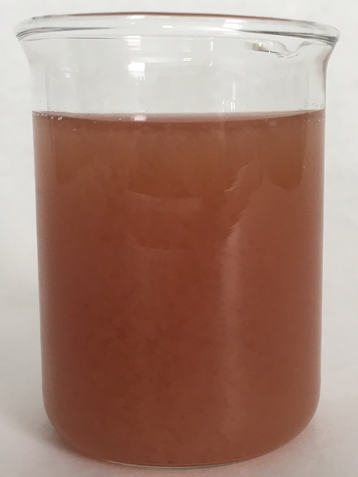 AOB & NOB cultures in pure concentrated form.
AOB & NOB cultures in pure concentrated form. - Nitrifiers are slow growers
Compared to most wastewater heterotrophs, nitrifiers are slow growers. Even in the best conditions, AOB take up to 12 hours for cell division. Remember that many common heterotrophs can divide every 30 - 60 minutes. - Nitrifiers obtain less energy from their metabolism
A fancy way to say that both AOB & NOB don't get as much food from oxidizing ammonia and nitrite when compared to the BOD (organic) degrading microbes. - Requirements for abundant oxygen
Many wastewater microbes can thrive at D.O. residuals below 1 mg/L. But oxidizing ammonia into nitrate requires a lot of oxygen. Therefore, AOB & NOB do best when D.O. is abundant. Depending upon your MLSS and EPS levels, this can be a D.O. residual between 2 - 4 mg/L (it all depends upon the system). - Easy to inhibit or kill
Nitrifiers are inhibited by many common compounds. While more of a problem in industrial systems, nitrifiers are easily damaged by amines, solvents, sulfides, and phenol. Even high organic loadings lower D.O. which results in inhibition. - Like a narrow range of environments for growth
Growth is best in pH between 7.5 - 8.2. Temperatures 20 - 38 Deg C. Outside this range, growth rates decrease to critical levels.
- Check your D.O. meters often. Remember D.O. residuals at the probe are not the same as seen by flocculated bacteria.
- Is your sludge age long enough to prevent nitrifier washout. If sludge age < reproduction time, the nitrifer populations will decrease eventually causing effluent ammonia and nitrite breakthrough.
- Do you have acute toxicity (easier to find) or chronic toxicity (requires more detective work).
- If ammonia and nitrite are a consistent issue, we can improve monitoring of the AOB/NOB populations using a combination of molecular (DNA) testing. MCA finds which nitrifer organisms are present. Once we know what is there, we can use qPCR (a fast, quantitative test) to track your system specific nitrifier populations. This way, you can take corretive steps before effluent problems arise.

 RSS Feed
RSS Feed